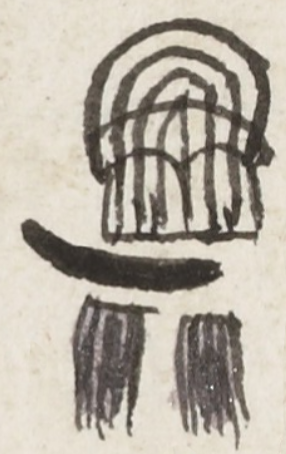ichtecqui (Mdz71r)
This black-line drawing of the simplex glyph for the noun ichtecqui, thief, actually depicts a cutting action (tequi, the verb meaning to cut) that involves a curved, black flint blade, a phonetic indicator. The blade is cutting a skein of maguey fiber (ichtli), according to Gordon Whittaker (Deciphering Aztec Hieroglyphs, 2012, fig. 2.19). The fiber (ich-) provides a phonetic indicator. A pair of front teeth are faintly visible at the top of the skein of fiber, as though the artist/writer was originally going to create a glyph that would involve the locative suffix -tlan (from tlantli, teeth).
Stephanie Wood
The cutting action provides the phonetic value tequi, which is a clue to the noun ichtecqui, ladrón or thief. In another glyph for ichtecqui, we see a person opening a box as though about to steal something. The visuals for these glyphs could equally stand for the verb, ichtequi, to steal.
Stephanie Wood
ladron
ladrón (thief, in English)
Stephanie Wood
c. 1541, or by 1553 at the latest
Stephanie Wood

ichtecqui, thief, https://nahuatl.wired-humanities.org/content/ichtecqui
ichtequi, to steal, https://nahuatl.wired-humanities.org/content/ichtequi
tequi, to cut, https://nahuatl.wired-humanities.org/content/tequi
ich(tli)>, maguey fiber, https://nahuatl.wired-humanities.org/content/ichtli
Codex Mendoza, folio 71 recto, https://digital.bodleian.ox.ac.uk/objects/2fea788e-2aa2-4f08-b6d9-648c00..., image 152 of 188.
Original manuscript is held by the Bodleian Libraries, University of Oxford, MS. Arch. Selden. A. 1; used here with the UK Creative Commons, “Attribution-NonCommercial-ShareAlike 3.0 License” (CC-BY-NC-SA 3.0)

